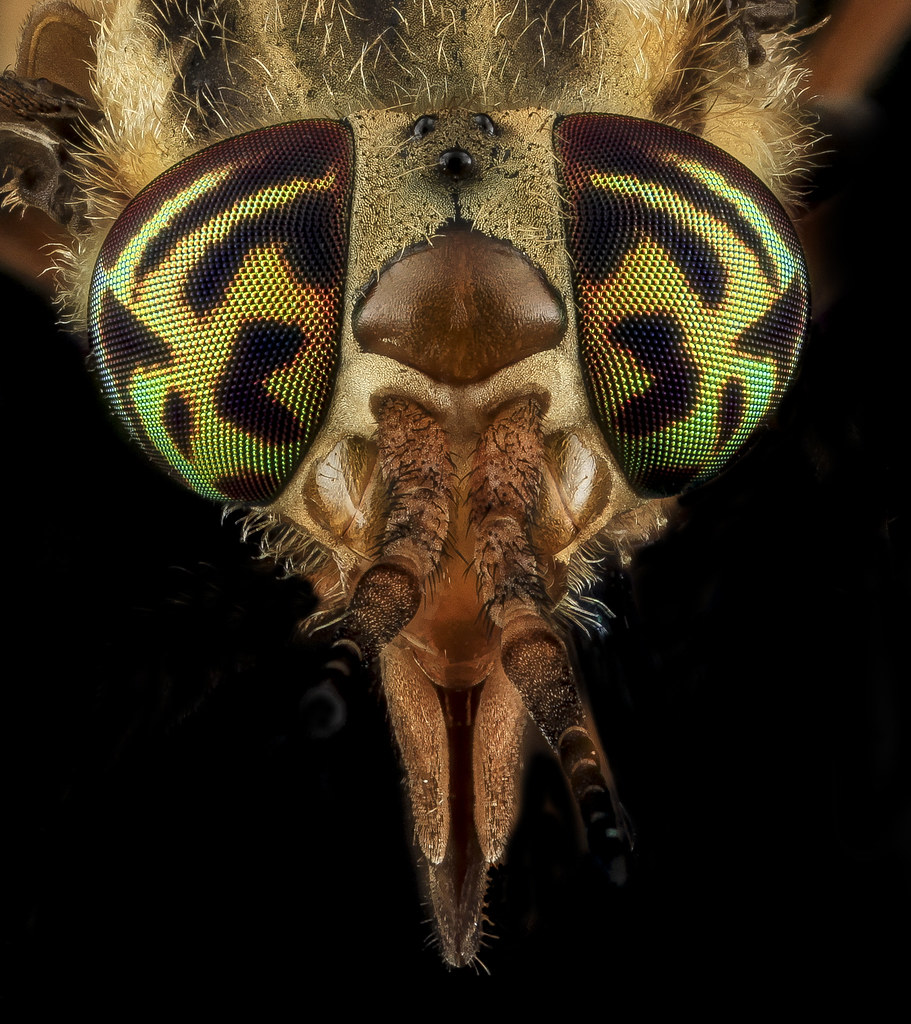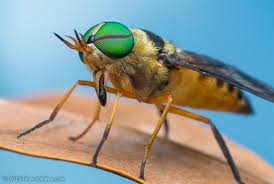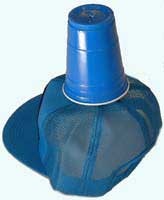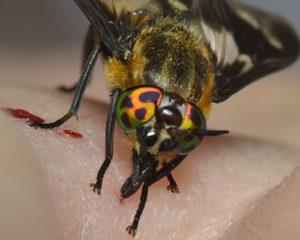Fly Wars

IT’S GOTTEN TO BE that season here again in southwest Florida, that maddening season of the flies. These are the close, heavy days of August when the biting bugs are out in force and hungry for blood. These are the humbling, soul-testing days when the tolerable annoyance ramps to the relentless assault that will slap that smug Zen smile right off the Buddha’s face.
Sunday mornings are usually reserved for the ramble, for the aimless neighborhood wander in worship of bird and flower, dirt and cloud, and the impish side pleasure of sensing Mrs. Kravitz worriedly spying through her window shades. But these mornings the ramble more resembles the frantic retreat, pitting the swarms of little flying ninjas against one half-naked slug of easy meat.
My harassers come in three forms of fly, two of whom—the mosquitoes and gnats—seem tolerable enough, given my armoring of chemical repellent and a constant state of motion. But the third is a fly of a different stripe. The deer fly scoffs at the bug dope, and reacts to my movement like a cat to a mouse. Though all three bugs like to draw human blood, the deer fly comes with weaponry of a more medieval caliber. The deer fly has twin sabers growing out of its face. With which it stabs you. As often as you will allow. This is where that aforementioned Buddha comes in.
When the deer fly alights, your options are as much philosophical as physical. You may wave it away and gently whisper that it go in peace. To which it will circle back and strike again. And again and again, until it teases out that murderous alter ego who lurks in all men’s psyches.
Rather soft and squishable, the deer fly does not suffer blows lightly. And once those sabers are sunk to the hilt, and that spongy fly tongue is drunkenly lapping up your lifeblood, they’re mortally slow at the getaway. Which means that I get to ponder my godlike powers before administering divine judgement.

Beauty with a bite
RARELY DO I PONDER as much as I should. As one who has spent a good part of his writing life extolling the virtues of meat-eating beasts, my public position toward those of the predatory lifestyle is one of benevolent coexistence. As one who now finds himself as prey to these relentless little sabertooths, my primal reflex is a vengeful strike.
Two times out of three the fly evades, leaving the supposedly more sapient of the contestants slapping his own face. But for one of those three swings the hand connects, sending kamikaze fly death-spiraling to the dust.
Hence my moment of reflection. Looking down on that fallen fly, kicking on its back, my rote rationalization is one of warped biblical justice, a perverted eye-for-an-eye sort of thing. You bite me, I kill you. But once the sting subsides and temper cools, the conscience is left to deal with the double standard of my revenge.
I live in a house where we regularly escort our freeloading ants outside, gently brushing and blowing them from the dogs’ bowls where they gather like quarry workers every morning. There is neither ant trap nor roach spray to be found in our cabinets; the fleet of exterminators who patrol the neighborhood have never been seen parked in front of our house. I scramble to rescue the occasional cockroach who scurries as I switch on the morning light, sparing her a grisly death by the resident pride of housecats who would happily dispatch it limb from living limb.
My wife is even worse than I. Kathy parks the car with windows cracked, lest a trapped spider or fly suffocate in the heat. She religiously rescues dazed honeybees off the sidewalk and escorts them to the nearest flower to recuperate.
Yes, friends and neighbors, we see you rolling your eyes. And understandably so. We are residents of the Lee County Mosquito Control District, the nation’s largest of its kind. We realize that our civilized life in these parts is made bearable to some degree by professional killers in helicopters and tanker trucks raining bacterial and chemical insecticides like Times Square confetti. We realize how precariously we inhabit what was until rather recently the most notoriously uninhabitable swamp in the land.
Our aboriginal predecessors in these parts must have been made of steel. They dealt with the bloodsuckers by coating themselves in mud, or the oils of certain plants, or—surely in supreme desperation—a certain foul unction of the gar fish. They would light fires to smoke their tormentors away. Some supposedly built up a tolerance over the ages, embracing a spartan sort of coexistence. And when neither smokescreens nor stoicism could endure the onslaughts, they simply fled, seasonally surrendering their homes to the bugs.
I HAVE HAD OPPORTUNITY to test a few of these defenses during travels in various worldclass bug hells. On one summer’s assignment canoeing the Great North Woods through the thick of its legendary black fly season, I experimented with the stoic method. (This after the ingredients in my Woodsman fly dope melted the engraving off my plastic pencil and left fingertip divots in my binoculars.) Local lore held that if I simply endured a certain number of bites early on, by season’s peak I would be imbued with a certain immunity. In fact, by season’s peak I was imbued with a certain nightly rash of itching welts and the beginnings of a neurotic tic, and ended up resigning myself to the toxic lotion, fortified now with a head net.
I once tried another variation of the stoic technique during a camping episode in the mosquito-happy heart of the Everglades. My partner at that time, a masochistic gourmet who insisted on preparing an elegant spread of French cuisine at the picnic table, did not anticipate the company our lantern would attract to the feast. And I, after about fifteen eternal minutes pretending to smile through the swarms, finally boiled over, and vowed in a fit of defiance that I would drink every last bug who dared land in my chalice of Cabernet. I’m here to report that the mosquitoes went down without complaint; the June bugs and moths not so readily.
Nor have I found gin to be a particularly good defense against the pests. One night in a remote outpost of the Bolivian Amazon, I awoke in the dark to the crashing of thunder, which turned out to be a cockroach dancing the rumba upon my eardrum. My fumbling finger unable to reach him, I tried flushing him out with the dregs of a martini resting handily at cotside. The thunder dance slowed to silence. But the woozy roach remained, and left me deaf in that ear until my return to civilization, whereupon a doctor excavated his remains.
IN MY FLORIDA EXPERIMENTS of late I have taken to testing the two leading commercial repellents: DEET (short for the ominous N, N-diethyl-m-toluamide) which, as previously noted, melts plastic; and picaridan, a pepper plant derivative which encouragingly, unlike DEET, has yet to be classified as a neurotoxin. Coating my left self in DEET, and my right in picaridin, I have found both products satisfactorily good at repelling the gnats and mosquitoes. But to those marketing sorts who label either potion the least bit effective against deer flies, a pox on you.
The deer fly eats DEET for breakfast. Those who work outdoors in deer fly habitat know well of what I speak. Choose your favorite poison or perfume—DEET, picaridin, citronella, lavender, or any of the thousand local mom-and-pop miracle recipes—all amount to snake oil so far as the deer fly is concerned. With all due respect to the honey badger, deer fly really don’t care.
Hence we arrive at the Trolling Deer Fly Trap. The Trolling Deer Fly Trap was invented some years ago by a University of Florida entomologist, Dr. Russ Mizell, who through trial and error, discovered a most effective fly defense in the form of a 6-inch flowerpot, painted bright blue, coated in glue, and attached to his truck mirror driven through fly territory at a rate not exceeding 7 miles per hour. One pass and Mizell would find the local deer fly population conveniently pasted to his flower pot.

Deer Flies Beware: The Trolling Deer Fly Trap
An enterprising biologist who learned of Mizell’s research invented her own personal, self-propelled trolling deer fly trap, rigging a sticky blue Solo cup to her ballcap. Let’s call it the Trolling Deer Fly Trap Cap. Let it stand as testimony to the lengths the outdoorsman will go to maintain a semblance of sanity in this creature’s company.

Trolling Deer Fly Trap — self-propelled model
My problem with the Trap Cap has nothing to do with vanity. Lord knows I look certifiable enough running down the street flailing at invisible foes, even without a beer cup balanced on my head. My problem is the prospect of having to deal with all those prisoners so helplessly mired there in the glue, beseeching me with those alien compound eyes, their little fly fates so utterly left to my hands. What to do with them now?
WHAT LITTLE I KNOW about flies tells me that question deserves some airing. Like me and you, flies feel pain. One of the equally wondrous and disturbing revelations of the behavioral sciences has been the recognition of sentience and suffering in animals we’ve long treated as automatons. (Sorry, but no: lobsters do not enjoy being boiled alive.) We’ve long known that octopuses are geniuses. And we have abundant evidence that even flies and their fellow insects think, learn, and communicate with each other. They flee things that hurt them—things dangerously hot or cold, things that shock them, things that would cause severe physical injury (my swatting hand, for example). Flies suffer their injuries. When, say, a scientist pulls a leg off a fruit fly—which of course they do—they note the injured fly becoming hypersensitive thereafter. “They try to protect themselves for the rest of their lives.”
The deer fly may act fearless, but it cares about its life. It would rather I didn’t crush it.
THUS MY MORAL dilemma over the deer fly. As I stand there rubbing my neck, glowering down at my fallen foe kicking in the dirt, my rudimentary grasp of fly biology confirms that this is a female fly. Only the ladies bite. And for the most noble of reasons: They are feeding their developing eggs with the only formula that works for them—blood. The fly I smacked was a mother to be, risking her life to care for her babies.

The lady likes her blood
So now how big and mighty do I feel? Which brings me back to pondering my more benevolent options of defense. The Trap Cap is out—too clunky for the minimalist who travels light—not to mention those aforementioned prisoners awaiting my verdict. Smear myself in fish oil? (Okay, but what about the fish?) Up and move my family to less buggy environs? (Too defeatist.) Abandon the ramble? (When I’m dead.)
Or how about a compromise? I know by now where my ambushers will most likely be waiting—like cougars, deer flies are territorial—and I know that they hunt by sight in the light of day. As I head out this morning, I will start in the dark, in the hopes of passing their hunting perches unseen.
But the sun also rises. And it will eventually expose me, as either a heroic fool or a vengeful fraud. Maybe if I just let each fly bite me once, they will take their little chunk of me and leave the rest in peace. Nope, already tried that—stood there and watched as a hungry little mom-to-be rewarded my generosity by drinking her bloody fill, then moving aside and promptly punching another vein.
If all else fails, as it will, I will resort to my last resort. I will flee with arms flailing. And I will run with the satisfaction of knowing that at least I’ve given Mrs. Kravitz something to gossip about during bridge night at the country club, even if I’m not balancing a beer cup on my head.
XXX
Brilliant but death to all flies!!!!